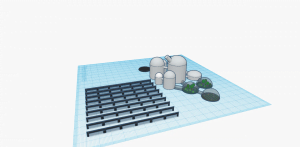Registrations are closed
In the future, to enable astronauts to stay on the Moon for long periods of time, new infrastructures must be developed to overcome important challenges. Such challenges include protection from radiation and meteorites, energy production, the extraction and recycling of water, food production and much more. The Moon Camp Challenge invites students to explore the Moon and decode some of the complexities future astronauts may face.
In Moon Camp Discovery each team’s mission is to 3D design only one component of a Moon Camp using Tinkercad. Teams can choose to design a:
– Lunar lander
– Moon Base
– Lunar rover
– Rocket
– Lunar Orbital Space Station
The design should be adapted to the Moon environment and if possible consider the use of local resources, provide protection and/or living and working facilities for the astronauts.
Moon Camp Discovery is a non-competitive mission for beginners. All teams that submit an entry that complies with the guidelines will receive a participation certificate and their project will be shared on the Moon Camp online platform.
Who can participate?
Participation is open worldwide to students aged up to 19 years old. Moon Camp Discovery is recommended for students aged 6 to 14 years old. Participating students must be supported by a teacher, educator or parent.
Discovery Projects Gallery 2020-2021
Below you can find some of the Moon Camp Discovery projects. For more projects visit the Moon Camp Discovery project gallery.
Team: International English School
Uppsala Sweden Category: Moon base
External link for Tinkercad 3D design
It has an observatory in the middle which is the main structure, with a lot of smaller buildings around it. You can get to the different structures by going through pipes. It’s grey with a red ESA on it.
The surrounding buildings contain stuff that you need for survival and a comfortable time, for example bedrooms and kitchens, while the main structure is more of the place where they do the research with laboratories. The astronauts get their oxygen, food and water from the 3 greenhouses. They get their energy from solar panels next to the base. The energy gets saved in batteries under the station for the long lunar nights. The astronauts sleep in beds hold down with bands to keep them from floating around.
The station is easy to take down and move, because everything is just modules. That means that you can expand the station infinitely (almost). The rounded roofs of the modules contain measuring instruments and stuff needed for communicating with earth. It also has a landing platform for rockets to land so that they don’t have to land on the rough lunar surface.

















